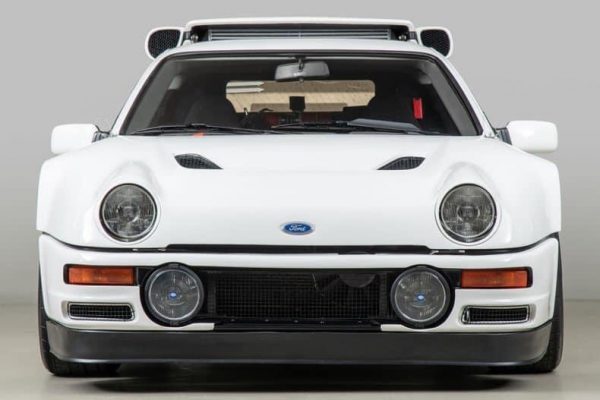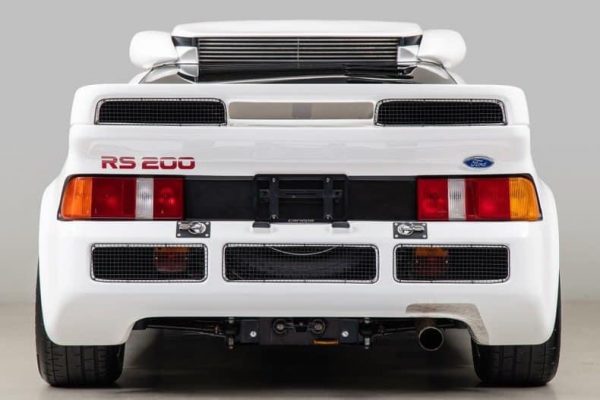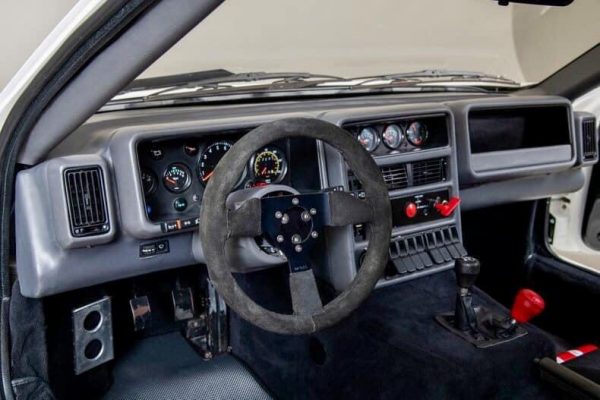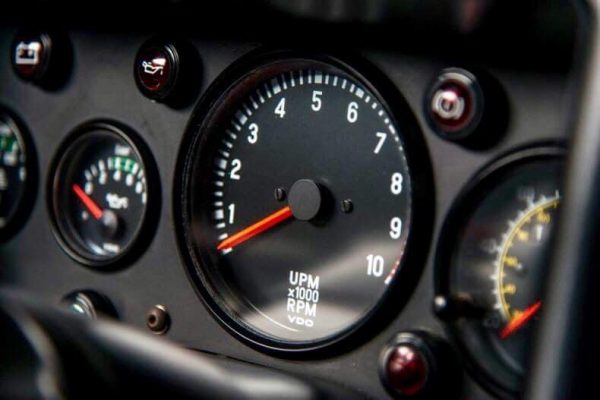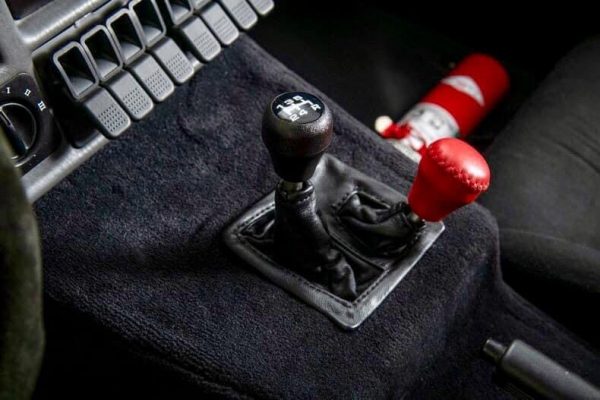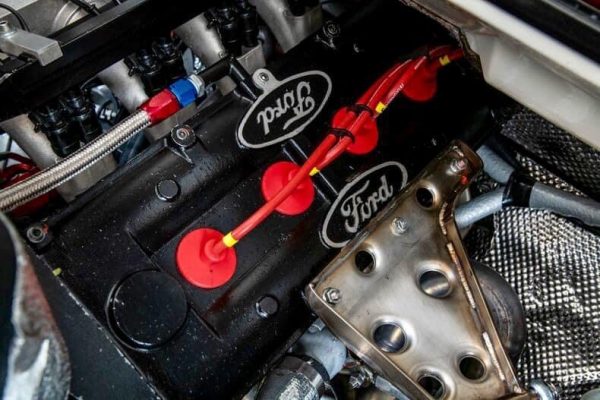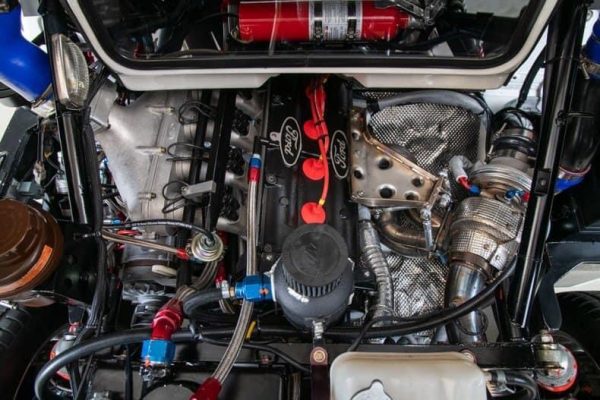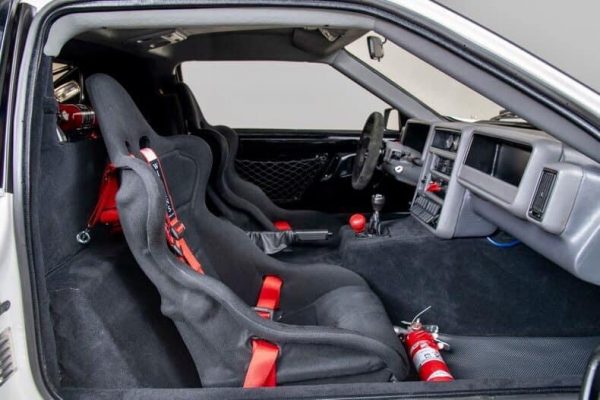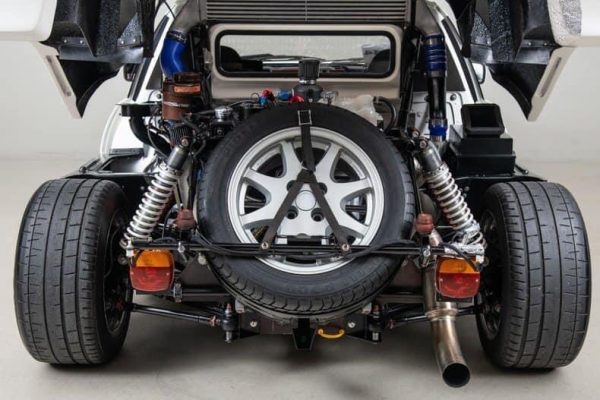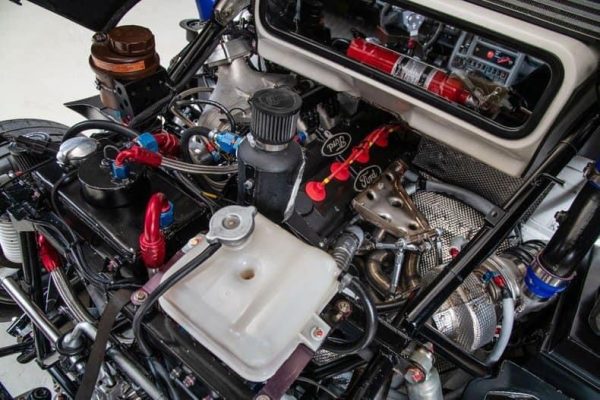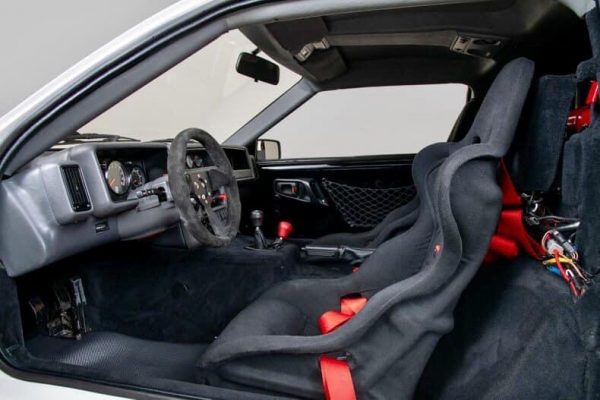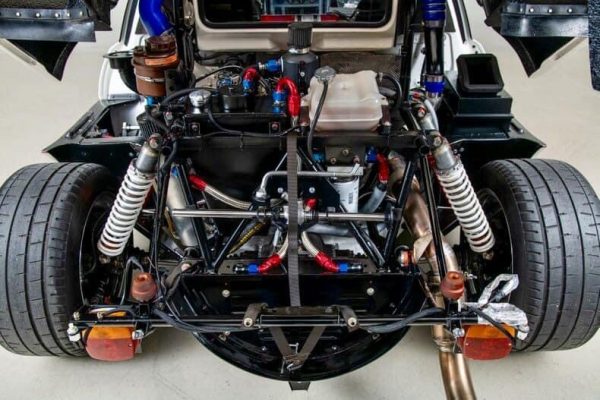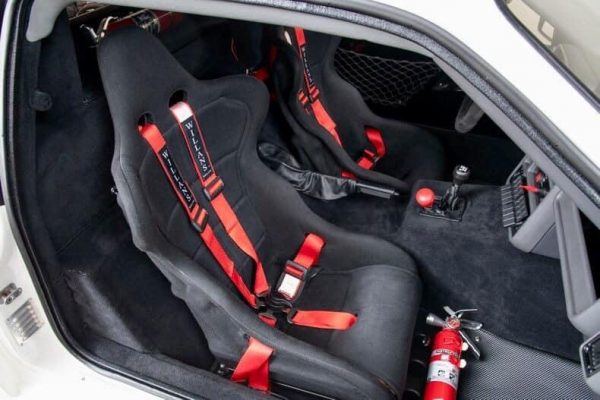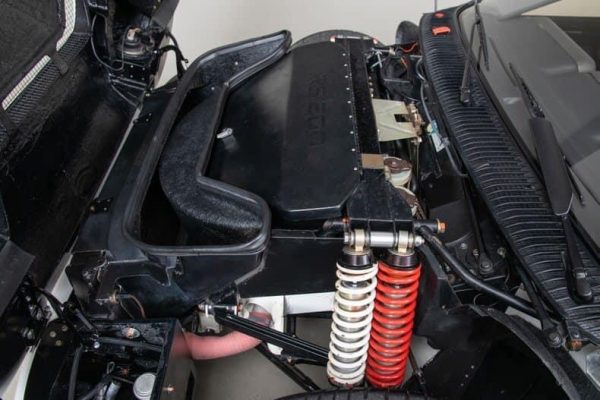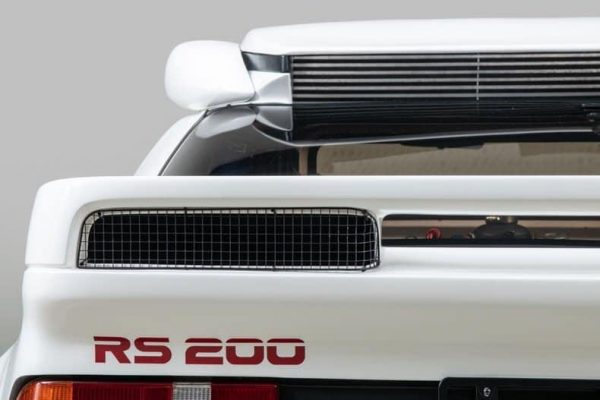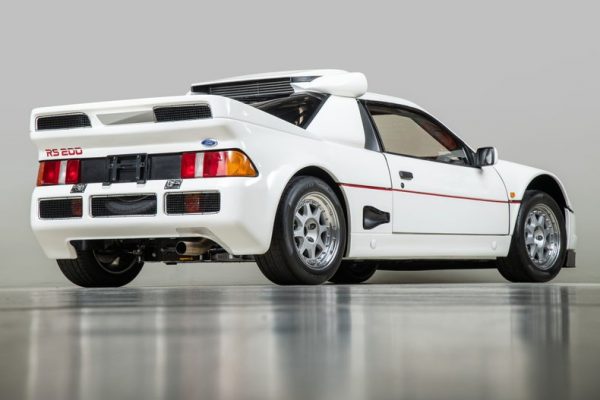Often considered as the Golden Age of rallying, the short-lived Group B era saw the birth of some of the most fearsome rally cars the world have ever seen. One of those cars was the Ford RS200, which was specifically produced by Ford of Great Britain in 1984 to race in the gruesome competition.
The unmistakable body was designed by Ghia, a famous design studio based in Italy, while the chassis was built from ground up by engineers Tony Southgate and John Wheeler. In its heyday, the RS200 was regarded as one of the most balanced cars in Group B thanks to its mid-mounted “BDT” engine from Cosworth.
To comply with FIA homologation rules, Ford built 200 road-legal RS200s, of which, just 24 were upgraded into a more potent version known as the Evolution. It goes without saying that these Evolution models are extremely rare but lucky for you, there is one that is listed for sale by a company called Canepa in California.
The particular car, chassis number 106, was stripped down and restored according to original specifications. The final assembly process was overseen by RM Motorsports of Wixom, Michigan. The company specializes in Ford racing cars, so you can be assured that the restoration work is accurate in every last detail.
At the request of the first owner, Frank Profera, the 2.1-litre BDT-E turbocharged inline-four engine was thoroughly reworked by Brian Hart Limited in Essex, UK. The result was an earth-shattering output of 704 bhp and 725 Nm, sent to all four wheels via a five-speed manual transmission. However, to improve drivability, its most recent owner had the power dialed down to a more civilised 615 bhp and 691 Nm.
Examples of component upgrades include a new Motec engine management system with a new wiring harness, a new ignition system complete with CDI box, modern turbocharger, new custom exhaust system and headers, new brakes and many more. The total cost of the restoration project is said to be over $212,000.
The price of the car is not stated but looking at the restoration cost alone, it could be well over $300,000. If that’s the case, this RS200 Evolution is more expensive than most supercars in the market, which brings us to the question: would you buy this, a Group B legend, or a modern supercar?

More about the RS200 Evolution below:
Conceived by Ford Motorsport and built in limited numbers, the RS200 was among the most exclusive and exciting sports cars of its era. Unveiled to the public in 1984, the new purpose-built Ford was an engineering tour de force, with an advanced four-wheel drive system, a turbocharged Cosworth engine, and a sophisticated suspension system intended to cope with the punishing conditions of rally racing. Not only was the RS200 a technical marvel, its Ghia-designed bodywork was visually striking and, even in standard street form, the car’s performance was truly staggering. For many years, The Guinness Book of Records listed the RS200 as the world’s fastest accelerating production automobile, achieving 0 to 60 mph in less than 3.2 seconds and a 0-100-0 time of just 12.6 seconds.
The 1.8-liter RS200, and its full-out competition variant, the more powerful 2.1-liter Evolution, marked Ford’s attempt to conquer FIA’s popular Group B formula. Though the series was canceled before Ford had a chance to fully develop the RS200’s potential, these extraordinary cars went on to achieve great success in rallycross, ice racing, hill climbs, and many other forms of motorsport.
Of the 146 RS200s sold – including the 24 Evolution variants – chassis 106 might well be the finest example ever to leave the Ford Motorsport works in Boreham, UK.
According to factory records, chassis 106 was custom-tailored to the exacting standards of its first owner, Frank Profera of Sherman Oaks, California. Intended for use as an exhilarating road car, this RS200 was specified as a left-hand-drive Evolution model, finished in white and outfitted with a fully trimmed interior, Speedline split racing wheels, power steering, a suede-wrapped MOMO steering wheel, and rally-spec AP Racing brakes. As indicated on the Manufacturer’s Statement of Origin, this bespoke RS200 developed 600 hp – nearly 100 hp more than a standard Evolution – through the use of a ported Mk II head, larger turbocharger, IMSA-spec intercooler, cockpit adjustable-boost dial, and 4″ works rally exhaust system. Completed and prepared for delivery to California in spring 1989, this specially tuned RS200 commanded a lofty retail price of £63,357.55 ($93,509.)
Amazingly, the RS200’s initial performance was not enough to satisfy Mr. Profera, who eventually sent the engine to Brian Hart Limited in Essex, UK, for further tuning. Mr. Hart had overseen the development of the RS200 Evolution engine for Ford Motorsport, and his reputation for creating high-performance engines was well known throughout the racing world. Working in tandem with East Coast Racing, Mr. Hart designed a second ECU, with full mapping for street use, along with other modifications for reliability and strength. The result was an engine that produced 704 bhp at 8,000 rpm with 535 lbs./ft of torque at 5,550 rpm.
In a letter written by Bob Howe, a former vehicle development manager who worked on the RS200 project with Ford Motorsport, he testifies to chassis 106’s revered status. “In my opinion the changes Frank made turned this car into the most unique example of the RS200 anywhere; certainly, I don’t know of another which has been boosted so much, made safer and legal for road use as well as having been made ‘civilized,’” Howe wrote.
Since leaving Mr. Profera’s hands in 2003, the RS200 was owned and maintained by prominent collectors including David Kedward, a noted UK enthusiast with a passion for historically significant rally cars.
In the care of the previous owner, chassis 106 was faithfully and sympathetically restored. Autometric European & Exotics in Pontiac, Michigan, refinished the RS200’s exotic bodywork while Hall of Fame Designs of Dearborn, Michigan, carefully re-trimmed the interior in correct OEM materials. Once the cosmetic restoration was completed, RM Motorsports of Wixom, Michigan, a firm specializing in Ford racing cars, oversaw the final assembly process and meticulously overhauled the car’s chassis and mechanical components.
The EVO was later acquired by one of Canepa’s long-time clients who has one of the significant automotive collections in the United States. Driving the Group B rally car seldomly, he kept it for a few years before sending it to Canepa so that a new caretaker who would continue to enjoy the car would be found. Naturally an extremely rare car such as the RS200 EVO did not take long in finding a new enthusiastic owner, but Canepa and this new owner had big plans for the Ford.
The new owner had every intention to drive the Ford often and wanted to ensure that it would drive in a manner that would allow him to spend a significant amount of time in it on the road. It was decided that while the RS200 EVO was a fantastic car it was much like original Porsche 959s, with their original technology being cutting-edge at the time that now was becoming outdated. Undeterred, Canepa made the plan to continue to develop this RS200 EVO beyond what has been seen before, with the ultimate goal ensuring that the drivability would be improved dramatically. Being that the RS200 EVO was built as a race car for the street, greatly improving the drivability without sacrificing performance would be paramount. During the span of more than a year and a half, countless components were designed, upgraded, and installed on this Group B street car that resulted on the highest-developed RS200 Canepa has ever seen.
During this development, Canepa and its technicians looked throughout the car to see what could be improved upon and began making a comprehensive checklist. The RS200 EVO benefited from a complete engine rebuild in-house with new camshafts to prepare for the other upgraded components to support it. This included a new Motec engine management system with a new wiring harness, a new ignition system complete with CDI box, wires, and spark plugs, modern turbocharger, new air filter housing inlet, new custom exhaust system, new custom headers, and a new pressure plate and release bearing. Other items were upgraded as well, with the brake system receiving a noticeable amount of attention in the form of Nikasil-coated brake caliper piston bores, and new cryo-treated brake pads and rotors. A full service was also done of all usual systems such as oil, transmission, coolant, etc. After completion of the Canepa-upgraded RS200 EVO, the car was fully tuned on Canepa’s dyno that yielded an astounding 615 horsepower and 510 lb-ft of torque, with a greatly improved power and torque curve that dramatically improved drivability. In all, the complete set of upgrades designed and built for this RS200 EVO tallied a total of over $212,000.
With the upgrades completed, the RS200 EVO was a true monster of a road car but now more agile and livable on the street. With more road-car manners but retaining its race-car performance, it lives the best of both worlds for its owner. The happy owner took delivery of the car after the upgrading at Canepa’s facility, citing its excellent driving dynamics and sheer amount of fun that he could now have in it. After enjoying the EVO for a year and a half, he decided that someone else should be able to enjoy the car in the same way that he did.
Each and every collector car that comes to Canepa is put through and extensive and diligent process called the “Canepa Difference.” This includes a major and comprehensive mechanical inspection where all systems are checked and serviced as necessary. They also receive an award-winning concours-level detailing, a thorough cleaning of each and every surface that ensures that every car is a sight to behold. Finishing off with a foam-pad-only polish to enhance the paint finish, each and every car is a perfect example and a personification of Bruce Canepa’s impeccable attention to detail.
Today, this exceptional RS200 Evolution is accompanied by a comprehensive file containing important Ford factory documents, registration records, EPA and DOT declarations, and recent restoration invoices and outlines from Canepa’s comprehensive upgrade. Also included in the sale is a cache of spare components, including a new gear cluster, drop-gear set, clutch, rear-suspension arms, the original ECU and related fittings, as well as a very rare RS200 owner’s manual, factory brochure, and fully bound shop manual.
The unique combination of rare factory options and performance upgrades, Brian Hart’s engine development, superb provenance, outstanding presentation, and Canepa’s immense number of mechanical upgrades for improved drivability make chassis 106 a particularly fascinating and desirable RS200. For the forward-thinking collector, this one-of-a-kind RS200 Evolution is a true prize, and it represents an exciting opportunity to acquire what many would consider to be the holy grail of Group B homologation specials. Being that this car has received a plethora of performance-enhancing upgrades from Canepa, the same group known for evolving the Porsche 959, it is quite possibly the most highly-developed RS200 Canepa has ever seen, and brought into the 21st century.



